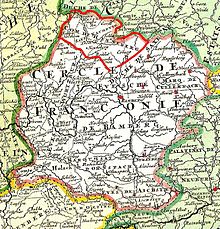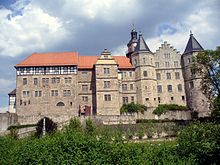County of Henneberg
|
Territory in the Holy Roman Empire |
|
|---|---|
| County of Henneberg | |
| coat of arms | |

|
|
| Coat of arms of the princes of Henneberg ( Schleusingen ) 1310–1583
|
|
| Consist | 1096-1660 |
| Arose from | Popponen |
| Form of rule | Grafschaft Henneberg, 1310 princes Grafschaft Henneberg, 1583 Electorate Saxony |
| Ruler / government | Count, 1310 Prince Count of Henneberg, 1583 Elector of Saxony |
| Today's region / s |
DE-TH , DE-BY ,
|
| Reichskreis | Franconian Empire |
| Capitals / residences | Henneberg , Botenlauben , Strauf , Schleusingen , Aschach , Römhild , Hartenburg |
| Dynasties | Henneberg , 1583 Wettiner |
| Denomination / Religions | Lutheran since the Reformation |
| Language / n |
German ( Hennebergisch )
|
| Incorporated into |
Saxony-Meiningen
|
Grafschaft Henneberg was a Franconian county between the Thuringian Forest and the Main and comprised areas of the Rhön , Grabfeld and Haßberge . It existed from the end of the 11th century to 1660 and was founded by the Counts of Henneberg , who ruled in several lines. The most important line, Henneberg-Schleusingen, ruled an imperial and princeed county from 1310 until the Hennebergs died out in 1583. In 1660, various Wettin lines divided the county among themselves.
The largest expansion of the county extended in an east-west direction from today's districts of Coburg and Sonneberg to Bad Salzungen ; in north-south direction it reached from Ilmenau to Mainberg before the gates of Schweinfurt . The Henneberger Land , which emerged from the former county of Henneberg, belongs, like all of southern Thuringia, to the transnational region of Franconia , which connects Bavaria , Thuringia , Baden-Württemberg and Hesse in terms of cultural history.
The princes of Henneberg

From a temporary weakening of the Franconian central power and the loss of the Franconian imperial estate , the collapse of the Franconian county constitution and the ensuing feuds and power struggles, the Counts of Henneberg , who moved to their ancestral castle, Henneberg Castle near the town of Henneberg in today's Schmalkalden district -Meiningen called out as the winner.
The sex was first mentioned chronically in 1078 and in a document in 1096. The counts of Henneberg first appeared with Count Godebold II . The Henneberger descended from the Bamberg family of the Popponen . In 1190 the house was divided into the lines Henneberg, Botenlauben and Struphe and Strauf. In 1274 the main division of Henneberg into the Henneberg- Schleusingen , Henneberg- Aschach - Römhild and Henneberg- Hartenberg lines took place , whereby the political unity of the northern franc was lost. The Schleusinger , based at Schloss Bertholdsburg, emerged from this division as the most powerful line . Henneberg-Schleusingen also existed the longest, until 1583. In 1310, Berthold VII von Henneberg-Schleusingen, who had received the Henneburg in 1274, was raised to the rank of prince. From then on the county bore the title "Fürstete Grafschaft Henneberg".
After the Dukes of Meranien died out in 1248, areas around Sonneberg and Coburg fell to the Counts of Henneberg. There were family ties between the two noble houses (marriage of Poppo VI., Otto von Botenlauben's father , with Sophie of Istria around 1165). This area was lost to the Askanian Electorate of Brandenburg as the Care of Coburg in 1291 , but returned as a dowry in 1312 to the County of Henneberg, which has now been duchess, and thus reached its greatest territorial extent.
The Hennebergers also held the burgrave dignity in Würzburg from 1157 to 1354 . However, this was lost in the power struggle with the Würzburg bishops as well as territorial possessions (e.g. around Münnerstadt ). The most important cities of Henneberg were Schmalkalden , Coburg, Suhl and, from 1542, Meiningen . With extensive mining and arms manufacturing, Suhl formed an economic center, in Meiningen the textile and metal crafts as well as the brewing industry were strongly represented, while the other cities served as residences and sources of culture and art. The spiritual center of Henneberg was the Premonstratensian monastery Veßra (now the Hennebergisches Museum Kloster Veßra ), founded by the Hennebergers in 1131 , which served as a burial place for almost all generations.
In 1353/1397, with the care of Coburg, a significant part of the county was lost to the House of Wettin as Katharina's dowry († 1397) at the wedding with Frederick the Strict . Friedrich IV , who emerged from this marriage, was the first elector of the Wettin family. The now Wettin care of Coburg was in the following period with the Saxon Landwehr from the now much smaller county of Henneberg.
The county of Henneberg belonged to the Franconian Empire until 1806 . It had a bridging function between Franconia and the Thuringian / Saxon area . With the exchange of the Mainberg from Henneberg in 1542 for Meiningen from Würzburg, on the one hand, the final withdrawal from the Main took place, and on the other hand, an advantageous consolidation of the territory was achieved. Count Georg Ernst von Henneberg-Schleusingen, co-regent of his father Wilhelm VI since 1543, joined the Reformation in 1544 , although his father initially remained faithful to the old faith. Lack of money led to a bond to the Wettin Sachsenhaus, as no partner could be found in the Catholic franc. On September 1, 1554, in the town hall of Kahla between the Ernestine dukes Johann Friedrich II. , Johann Wilhelm I and Johann Friedrich III. the younger as well as Count Wilhelm VI., Georg Ernst and Poppo von Henneberg-Schleusingen decided on the Ernestine-Henneberg hereditary brotherhood .
resolution
The Kahla contract with the Wettins provided for Henneberg to be taken over by Saxony if the Henneberger line died without children . This case occurred in 1583. The rule of Schmalkalden came to the Landgraviate of Hessen-Kassel . Saxony was able to expand its power to Franconia - after the dynasty of the Counts of Henneberg, seven twelfth of the Henneberg possessions came to the Ernestines , who initially remained in joint administration with the remaining five twelfth of the Albertines, based in Meiningen. Since Ernestines and Albertines could not agree on the inheritance, the county of Henneberg was dissolved in 1660/61 and the Weimar portion of the former county was combined with the Duchy of Saxony-Weimar ; Gotha's share merged with the Duchy of Saxony-Gotha . Splitting of these lines into ever smaller Ernestine duchies led to the further fragmentation of the Henneberg territory. The Albertine share went to the Duchy of Saxony-Zeitz until 1718 , then fell back to the Albertine main line and, in 1815, after the wars of freedom, went together with more than half of the Kingdom of Saxony - areas of the former spa district (Wittenberg) , the Thuringian district (Langensalza ) and the Neustädter Kreis as well as the Merseburg and Naumburg-Zeitz monasteries - in the possession of the Kingdom of Prussia via: Province of Saxony ( Schleusingen district ). With the Duchy of Saxony-Meiningen , which was enlarged from 1826, one of the successor states of Saxony-Gotha ensured the first partial reunification of the region in the 19th century.
The hen as the heraldic animal of the county is included in the coats of arms of the numerous successor states, for example the
- Principality of Saxony-Coburg ,
- Duchy of Saxony-Meiningen,
- Duchy of Saxony-Altenburg ,
- Duchy of Saxe-Coburg and Gotha ,
- Grand Duchy of Saxony-Weimar-Eisenach ,
- Kingdom of Saxony and the
- Kingdom of Prussia .
The formation of the Weimar Republic brought about a further amalgamation of the former Henneberg region with the establishment of the state of Thuringia . The Free State of Coburg joined the Free State of Bavaria. The areas around Schmalkalden and Schleusingen remained part of Prussia until 1945, formally until 1947.
Until 1806 the county of Henneberg formally existed as part of the Bank of the Counts in the Franconian Empire.
The Catholic Christians in what is now southern Thuringia were assigned to the diocese of Würzburg until 1973 . An interim solution existed until 1994, when the area was assigned to the newly founded diocese of Erfurt .
Henneberg today
The Henneberg past south of the Rennsteig is particularly evident in the common Franconian dialect . The old Henneberg region today corresponds to the cultural-historical landscape of Henneberger Land in southern Thuringia with the districts of Bad Salzungen (now in the Wartburg district ), Schmalkalden-Meiningen and Hildburghausen and the independent city of Suhl. Depending on the point of view, parts of the districts of Rhön-Grabfeld , Bad Kissingen , Haßberge , Schweinfurt (administrative region of Lower Franconia ), Coburg (administrative district of Upper Franconia ), Sonneberg and Ilm-Kreis ( Thuringia ) are also included.
Significant structures

- Aschach Castle
- Bertholdsburg , Schleusingen
- Breitungen Castle
- Veste Coburg
- Hallenburg
- Veste Heldburg
- Henneberg Castle
- Castle Hohenstein
- Hutsberg castle ruins
- Johanniter Castle Kühndorf
- Mainberg Castle
- Glücksburg Castle , Römhild
- Hartenburg castle ruins
- Straufhain castle ruins
- Veßra Monastery
- Maienluft castle ruins , Wasungen
See also
swell
- Petrus Schenk : Accurate geographical delineation of the Gefürsteten Graffschektiven Hennerg, Chursaechsischen Antheils exists in which Aemmtern Schleusingen, Sula, Kühndorff with Bennshausen. In addition to the cities, towns and villages located in it, they also designed other neighboring areas. Reprint of the Amsterdam, Schenk, 1755 edition. Rockstuhl, Bad Langensalza 2003, ISBN 3-936030-15-4 .
literature
- Gerhard Köbler : Historical Lexicon of the German Lands. 7th, completely revised edition. Beck, Munich 2007, p. 268.
- Johannes Mötsch (Hrsg.): Regesten of the archive of the counts of Henneberg-Römhild. 2 volumes. Böhlau, Cologne et al. 2006, ISBN 3-412-35905-X ( Publications of the Historical Commission for Thuringia. Large series 13, 1–2)





